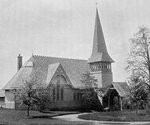Friday, July 26, 2024
First Presbyterian Church of Oyster Bay is still going strong after 150 years
A week of celebration and service in Oyster Bay
The First Presbyterian Church of Oyster Bay has stood at the center of Oyster Bay, and the spiritual life of many of its residents, since 1873. Now, with the 150th anniversary of the dedication of the building approaching, the church and its congregation are looking forward to celebrating its long and proud history.
Although First Presbyterian’s ministry had been active in the hamlet since 1842, in its first decade it lacked a permanent building. By the early 1850’s they had a small church building where the rear half of what is now Nobman’s Hardware stands, but eventually faced financial difficulties and had to abandon it.
Under the leadership of the Rev. Benjamin L. Swan, its pastor, the church’s finances were restored by the early 1870s, and construction on the current church began in 1872. It was built by an up-and-coming architect named J. Cleveland Cady, who would go on to design the American Museum of Natural History, buildings at Yale and Williams College, and the original Metropolitan Opera House.
The current pastor, the Rev. Jeffrey Prey, said that he and the other members of the church leadership have been planning the sesquicentennial celebration for several months. A re-dedication will be held on Sept. 24, the same day as the original ceremony, but there will be a week of celebratory and community-service events leading up to it, beginning on Sept. 17.
“We’re basically celebrating elements of worship, elements of fellowship and elements of service, moving beyond the bounds of the building into the world around us, where the church has had an outsized impact for its almost 200 years’ worth of existence,” Prey explained. “We want to celebrate and honor parts of our history, parts of our faith that require a certain weightiness to them, but always with fun.”
The church, which Theodore Roosevelt attended as a boy and where his father’s funeral service was held, will host a range of events over the coming weeks. The celebration, Prey added, is open to anyone, regardless of faith.
Christopher Hogg, co-head of Christian education at the church and a member of its session, or board, emphasized that making sure the activities were open to everyone was important to the church leadership.
He added that First Presbyterian has always welcomed new individuals and families, and that including the entire community fits its history and its commitment to service.
“The church is committed to playing an active role in our community,” Hogg said. “People use the term ‘church family’ a lot. But I really do think this is a family church.”
On Sept. 17, the church will hold its regular service at 10 a.m., followed by a cookout and carnival, which will feature a bouncy castle for children and an ax-throwing trailer for adults. From Sept. 18 to 22, the church will be open to visitors, who can tour the Carpenter Gothic-style building and enjoy light refreshments and a brief history each day from noon to 1 p.m.
First Presbyterian will also take part in a “faith build” with Habitat for Humanity on Sept. 23, in Suffolk County. The church has worked with the nonprofit organization several times in the past, and congregants have helped out with projects across Long Island over the years.
Finally, there will be a special celebration of the re-dedication service on Sept. 24, at 10 a.m., which Prey says will incorporate as many aspects of the original service as church researchers have been able to discover. That evening there will also be a concert by Gospera, a gospel music group that has performed at Raynham Hall Museum.
Ultimately, Prey said, the celebrations would not only honor the church and its history, but also give congregants a chance to reflect on their role in Oyster Bay and how they can continue to serve the hamlet they’ve called home for the past century and a half.
“It’s one thing to celebrate history, but you should always do it with an eye towards the future,” Prey said. “That’s the mark of this congregation, that it’s wonderful what our heritage is, but if we’re not thinking about what we can do tomorrow, then that history is really kind of meaningless.”
HELP SUPPORT LOCAL JOURNALISM
The worldwide pandemic has threatened many of the businesses you rely on every day, but don’t let it take away your source for local news. Now more than ever, we need your help to ensure nothing but the best in hyperlocal community journalism comes straight to you. Consider supporting the Herald with a small donation. It can be a one-time, or a monthly contribution, to help ensure we’re here through this crisis. To donate or for more information, click here.
Sponsored content
Other items that may interest you







